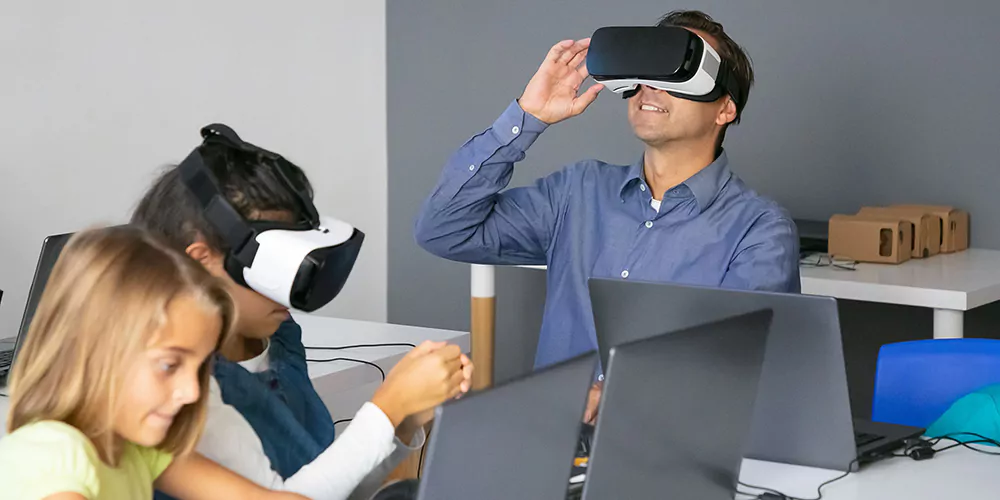In an era where the impacts of climate change are becoming increasingly apparent, the urgency to address this global challenge has never been greater. Climate dialogue, encompassing discussions, debates, and actions, plays a pivotal role in shaping policies, fostering public awareness, and driving collective action. However, traditional methods of communication often fall short in effectively conveying the complex nature of climate issues and engaging diverse audiences. Herein lies the potential of immersive technology, a powerful tool that transcends boundaries, enhances understanding, and fosters empathy. In this article, we explore the transformative impact of immersive technology on climate dialogue, elucidating its role in empowering leaders and engaging communities in the quest for a sustainable future.
Understanding Immersive Technology: Immersive technology encompasses a spectrum of technologies that immerse users in digital environments, blurring the lines between the physical and virtual worlds. This includes virtual reality (VR), augmented reality (AR), mixed reality (MR), and extended reality (XR). VR provides users with a fully immersive experience by transporting them to entirely virtual environments, while AR overlays digital content onto the real world, enhancing the user’s perception of reality. MR combines elements of both VR and AR, seamlessly integrating digital and physical environments, while XR serves as an umbrella term for these immersive technologies.
Empowering Climate Leaders Through Immersive Experiences: Effective leadership is paramount in addressing the multifaceted challenges of climate change. Immersive technology offers leaders innovative tools to deepen their understanding of climate science, visualize complex data, and simulate the impacts of policy decisions. VR simulations can immerse leaders in realistic scenarios, such as rising sea levels, extreme weather events, or deforestation, fostering empathy and informing decision-making. For instance, political leaders can virtually explore the consequences of different policy pathways, gaining insights into the interconnected nature of environmental, social, and economic systems. By experiencing the tangible effects of climate change firsthand, leaders are motivated to take bold and informed actions to mitigate its impacts.
Enhancing Climate Education and Awareness: Educating the public about climate change is fundamental to building a more sustainable future. Immersive technology has the potential to revolutionize climate education by offering immersive and interactive learning experiences. VR simulations can transport students to polar ice caps, coral reefs, or dense rainforests, allowing them to explore these ecosystems up close and witness the effects of climate change in real-time. AR applications can overlay climate data onto everyday objects, turning classrooms, museums, and parks into interactive learning environments. By engaging students in experiential learning, immersive technology fosters curiosity, critical thinking, and environmental stewardship, empowering the next generation of climate leaders.
Fostering Empathy and Behavior Change: At the heart of effective climate dialogue lies the ability to cultivate empathy and inspire action. Immersive experiences have a unique ability to evoke emotional responses and foster empathy by placing users directly in the shoes of those affected by climate change. VR documentaries, for example, can transport viewers to frontline communities facing the impacts of environmental degradation, eliciting visceral reactions and driving empathy-driven action. By bridging the empathy gap, immersive technology has the power to galvanize individuals and communities to adopt sustainable behaviors, advocate for policy change, and support climate resilience efforts.
Transforming Climate Communication and Advocacy: Traditional forms of climate communication often struggle to convey the urgency and complexity of climate issues in a compelling manner. Immersive storytelling offers a novel approach to climate communication, enabling storytellers, journalists, and activists to create immersive narratives that resonate with audiences on a deeper level. VR experiences, interactive documentaries, and immersive installations transport viewers into the heart of environmental narratives, fostering emotional connections and spurring meaningful dialogue. By leveraging the immersive power of technology, climate advocates can amplify their message, catalyze social movements, and drive systemic change.
Addressing Equity and Inclusion in Climate Dialogue: Central to effective climate dialogue is the principle of equity and inclusion, ensuring that diverse voices are heard and represented in decision-making processes. Immersive technology has the potential to democratize climate dialogue by breaking down barriers of geography, language, and accessibility. VR meetings and conferences enable participants from around the world to collaborate in virtual spaces, fostering cross-cultural exchange and inclusive decision-making. AR applications can provide real-time translations and accessibility features, ensuring that climate information is accessible to individuals with diverse needs. By prioritizing equity and inclusion, immersive technology can empower marginalized communities, amplify their voices, and drive climate action that is truly inclusive and equitable.
Overcoming Challenges and Ethical Considerations: While immersive technology holds immense promise for climate dialogue, it also poses certain challenges and ethical considerations. Technical barriers, such as cost, accessibility, and technological literacy, may limit the widespread adoption of immersive solutions, particularly in underserved communities. Moreover, concerns regarding data privacy, digital ethics, and virtual representation must be carefully addressed to ensure that immersive experiences uphold ethical standards and respect the rights of users. By proactively addressing these challenges and fostering ethical practices, stakeholders can harness the full potential of immersive technology to advance climate dialogue in a responsible and inclusive manner.
Conclusion: In an increasingly interconnected and uncertain world, effective climate dialogue is imperative for addressing the urgent challenges of climate change. Immersive technology offers a powerful means of engaging leaders, empowering communities, and fostering meaningful dialogue on climate issues. By leveraging immersive experiences, we can transcend boundaries, cultivate empathy, and inspire collective action towards a more sustainable and resilient future. As we navigate the complex realities of climate change, let us embrace the transformative potential of immersive technology to shape a world where dialogue leads to action and unity triumphs over adversity.
